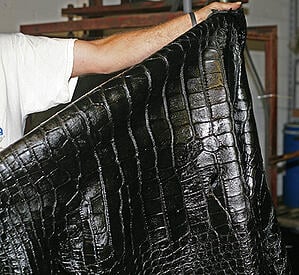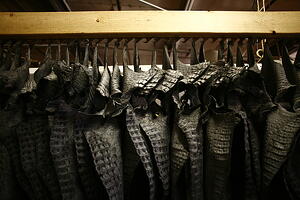 When it comes to high-fashion handbags and other items, exotic leathers are at the highest end of luxury. One of the most popular materials for the fashion-conscious is the supple, luxurious hide of the American alligator. Hailing from the Southeast USA and frequently harvested from farm-bred gators as well as from wild animals, American alligator skin is a classic, durable and versatile leather.
When it comes to high-fashion handbags and other items, exotic leathers are at the highest end of luxury. One of the most popular materials for the fashion-conscious is the supple, luxurious hide of the American alligator. Hailing from the Southeast USA and frequently harvested from farm-bred gators as well as from wild animals, American alligator skin is a classic, durable and versatile leather.
However, alligator skin is not the only crocodilian species used for high fashion. Caiman crocodiles are also used in the fashion industry by many. Hailing from South America and Central America, the caiman crocodile’s skin is taken only from farms.
While both skins are very desirable for high fashion, they are not the same. These two crocodilian species might be distant cousins, but they each have unique characteristics.
Characteristics of Alligator Skin
 Of these two species of reptile, the American alligator’s hide is the softer and more pliable material. This is because the skin of this reptile is less bony than the skin of the caiman.
Of these two species of reptile, the American alligator’s hide is the softer and more pliable material. This is because the skin of this reptile is less bony than the skin of the caiman.
This softness makes the alligator’s skin easier to work with than the skin of other reptiles, making it easier to work with for cutting, stitching and folding. In addition to making it easy to work with, the softness of alligator skin means that it feels much more supple to the touch than other reptile skins. The top global fashion powerhouses take advantage alligator skin to make a variety of ultra luxury products like belts, furniture, garments, handbags and wallets.
Another result of the lack of bone in alligator skin is that it is easier to give them a very smooth, even dye. Without the presence of calcium-rich deposits in the skin, dyes that are applied to a gator’s hide have the chance to be evenly distributed, which makes getting a uniform color into the hide less complicated. When you need to work multiple hides to have a uniform coloration in a large object, such as a piece of luggage, the cleanness and smoothness of an alligator’s scales could be considered one of alligator leather’s biggest advantages over caiman skin.
Speaking of luggage and other large items, the American alligator skins available in the marketplace can be much larger than the caiman crocodile. In fact, it is not uncommon for alligator hides to exceed 10 feet long. So, for items with large panels, you can get large alligator skins so that you don’t have to do as much cutting and seaming as you would with the hide of a smaller skin, such as a caiman crocodile.
Characteristics of Caiman Crocodile Leather
 While caimans might be cousins to the American alligator, the hides of the two animals are worlds apart. For starters, caiman hides tend to be stiffer than alligator hides. This is because the caiman has distinctive calcium rivets in the center of each scale. These calcium deposits also give the caiman’s scales a patterned effect that is not seen in alligator hides, one that may even persist through the dyeing process.
While caimans might be cousins to the American alligator, the hides of the two animals are worlds apart. For starters, caiman hides tend to be stiffer than alligator hides. This is because the caiman has distinctive calcium rivets in the center of each scale. These calcium deposits also give the caiman’s scales a patterned effect that is not seen in alligator hides, one that may even persist through the dyeing process.
Another key characteristic that separates caiman skins from alligator skins is their size. Caimans are rarely farmed to larger than 3-4 feet long while several alligator farms grow their animals larger. In addition, wild caiman skins are not available in the marketplace; whereas there are tens of thousands of wild alligator skins available each year, ranging from three feet to 15 feet long. This often means that for projects with larger panels, you will have to use more hides, do more stitching, and generally perform more work overall.
While the boniness of the caiman hide might lead some to regard it as being less useful or lower-quality, there are benefits to using this material. For starters, the skin of a caiman tends to be more structured than softer hides. For those who want to emphasize the natural qualities of the animal’s skin, the caiman skin is also a definite plus.
Caiman skin is used by brands in high luxury – just not quite ultra luxury like the alligator skin. Handbags and cowboy boots and other ladies’ footwear are common uses for the caiman skin.
Differences in Cost
Whenever you’re shopping for caiman and alligator skin, you may notice that there is typically a very large price difference between the two. Alligator skin is easier to work with and considered more luxurious than the caiman skin for the reasons detailed above, so both manufacturers and the consumer people will pay a substantial premium for it compared to the caiman’s skin. It is not uncommon for a caiman skin to be priced at a fraction of the cost of a comparable alligator skin.
For more information about caiman and alligator hides, or any other exotic leather, be sure to ask an expert today. Pan American Leathers has been a trusted tannery for major fashion houses for over 30 years.



